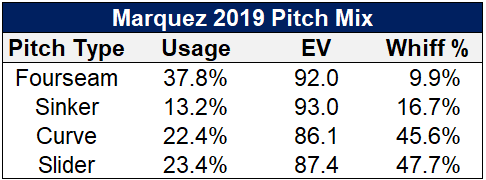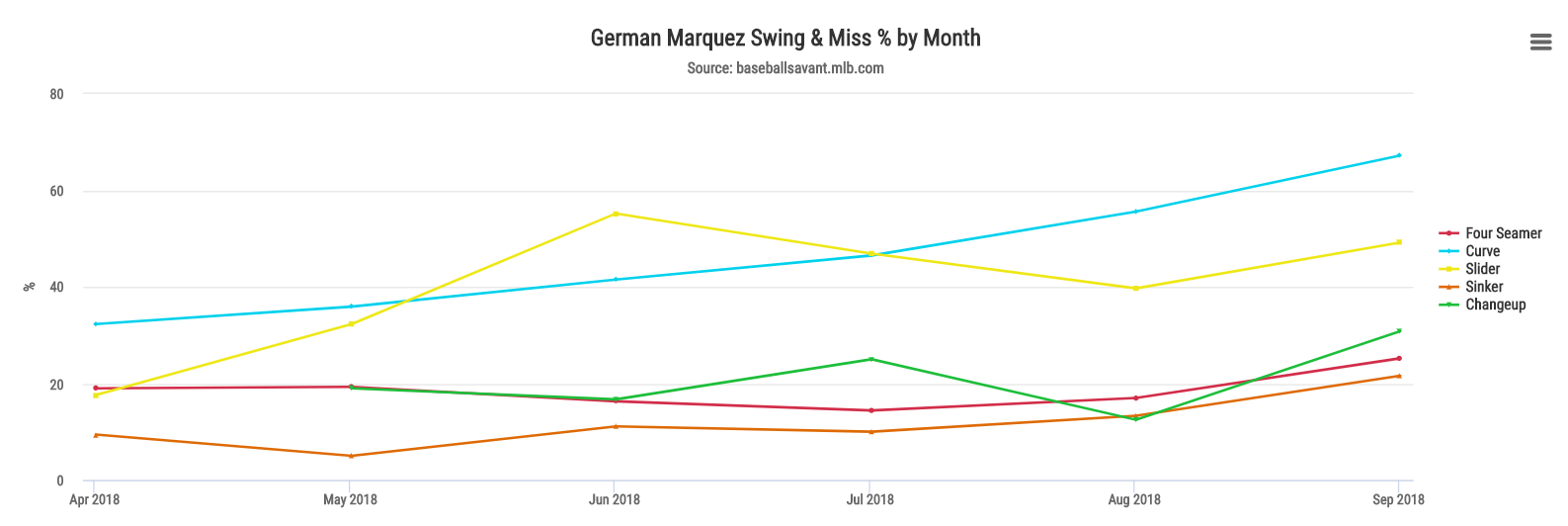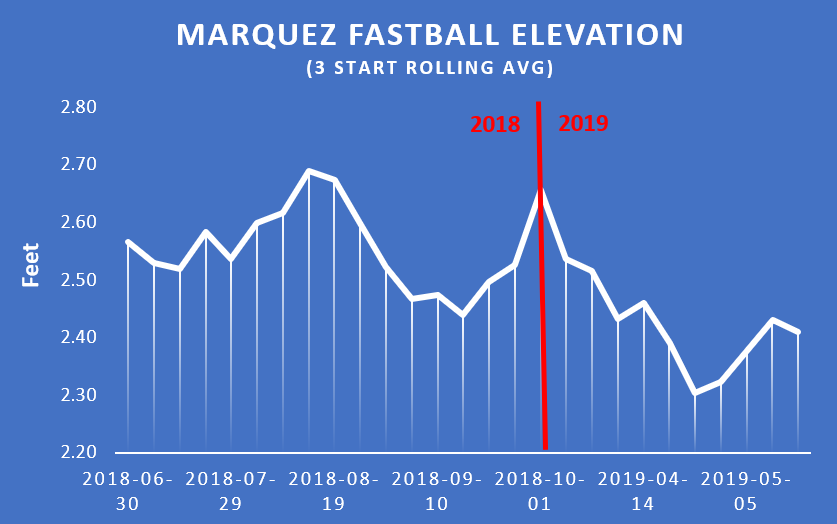After struggling in over his first 45 starts in the majors, German Marquez broke out in a big way in the second half of 2018, posting a sterling 2.47 ERA/2.42 FIP/2.28 xFIP to go along with a 33% strikeout rate in his final 17 starts of the season.
Yet despite that run of excellence, few players were as divisive heading into 2019.
Some analysts, myself included, were convinced that Marquez’s statistical dominance propelled him into the elite echelon of pitchers, while others were skeptical that a Coors-based pitcher could sustain such success over the long run.
Now that Marquez is 10 starts into his 2019 campaign, what have we learned? Is he the ace I claimed he was? Or is he regressing the way of Ubaldo Jimenez? For now, the truth seems to lie somewhere in the middle, with considerable upside present if Marquez can learn to command his fastballs as well as his breaking pitches.
A Brief Review
Marquez has pitched 64 innings over 10 starts in 2019 for an average of 6 1/3 per start.
Coming off a tough Wednesday outing against the Red Sox in Boston, Marquez now owns a 3.80 ERA/3.41 FIP/3.10 xFIP on the season. While that is certainly a respectable pitching line, especially for a Rockies hurler, it is more indicative of a second or third fantasy starter than a true ace.
Marquez’s 24.5% strikeout rate ranks in the 63rd percentile among starters this season, which is good but ultimately below expectations given the higher than 30% rate he posted in the second half of 2018. Fortunately, Marquez’s control has been elite, with his 4.5% walk rate and 5.4 K/BB ratio ranking among the game’s best.
Marquez’s extremely strong xFIP is buoyed his elite K/BB along with a 94th percentile ground-ball rate. His ground-ball rate is also the reason his HR/9 rests at a reasonable 1.13 despite an obscene 17% HR/FB ratio on the season.
Marquez has continued to post elite plate discipline metrics, with a 13.8% swinging-strike rate and 35.8% outside swing rate that measure in the 89th percentile.
The Bad
Let’s start with the negative side of the ledger on this one.
Marquez has always been a fairly hittable pitcher, even in the midst of his second-half breakout in 2018. That is, when hitters make contact, they tend to do so with average to above average exit velocities and barrel rates. The main reason for this is that, unlike aces such as Jacob deGrom, Justin Verlander, Gerrit Cole, and Max Scherzer, Marquez does not possess an elite fastball.
Despite elite 95 to 96 mph pitch velocity, Marquez’s four-seamer has been fairly easy for hitters to pick up in 2019, with a middling 9.9% whiff rate and 92 mph average exit velocity. Marquez’s sinker, which garners a few more whiffs, gets hit even harder with a 93 mph exit velocity. Meanwhile, Marquez’s curve and slider have continued to be elite, with mind-bending whiff rates higher than 45% and strong contact suppression.
Some might say that Marquez should simply throw his fastballs less. Unfortunately, I don’t think it’s that simple. One of the reasons Marquez’s breaking pitches are so effective is that he uses them disproportionately with two strikes after he throws his fastballs to get ahead in counts. His fastballs are loss-leaders of sorts, often serving as a vessel to steer the hitter to a count where he will be forced to flail at Marquez’s breaking pitches.
But a true ace needs to be able to earn whiffs with his fastball. And that is exactly what Marquez did in the second half of 2018, juicing four-seamer and sinker whiff rates each above 20% over the final months of the season.
Yet his fastball whiff rates have regressed significantly in 2019.
From an anecdotal perspective, it doesn’t seem like Marquez has much of plan for his fastball this year. It seems like he’s mainly trying to induce called strikes and foul balls early in the count with fastballs that hover over the middle of the plate rather than force whiffs with fastballs up in the zone.
Sure enough, the elevation on Marquez’s fastball has fallen precipitously in 2019 compared with the second half of 2018. While pitching lower in the zone is likely one of the reasons his ground-ball rate rests in the 94th percentile this year, it is also probably why his fastball whiff rate and his strikeout rate have declined.
For Marquez to regain the ace-like dominance he showed in the second half of 2018, he will need to show more confidence throwing his fastball up in the zone.
Coors Field
The 800-pound gorilla in the room with Marquez and any other Rockies pitcher is Coors Field. Pitching half your games in an environment that juices run scoring 30% to 40% above league average is a difficult obstacle for any pitcher to overcome.
And Marquez has not been up to the task this season, with a 5.34 ERA at Coors compared with 2.55 on the road, along with a 3.94 to 2.36 xFIP differential. Is this hard and fast proof that Coors is invincible?
To answer that question with any degree of confidence, we need to understand why Coors is a hitters’ paradise to begin with.
Coors significantly inflates slugging percentage on fly balls above expected metrics for two reasons: First, the thin air adds about 10-15 feet of distance to fly balls on average, which results in more homers. Second, the spacious confines of the ballpark, combined with the increased distance, allow more fly balls to convert from fly outs in other parks to doubles and triples in Coors.
Marquez’s SLG-xSLG on fly balls in Coors thus far in 2019 is a ridiculous +.698, which is more than double the +.283 reading the ballpark earned as a whole from 2016-18. This likely means that Marquez has been unlucky on fly balls and that his HR/FB ratio, ERA, and FIP are set to regress downward.
Moreover, Marquez has been the recipient of some poor luck on ground balls, with a SLG-xSLG almost five times the standard ballpark rate. This is an indication that his .402 BABIP in Coors will regress downward as well.
Some of the positive regression Marquez receives on flies and grounders at home will be offset by negative regression on line drives. Additionally, Marquez’s road production this season will likely worsen, with his .225 road BABIP due for a hefty increase in the near future.
Coors is not some mythical creature that cannot be slain. If a pitcher manages to strike out more than 30% of hitters he faces while keeping more than 50% of batted balls on the ground, he should be able to neutralize most of the fly-ball-friendly tendencies of the ballpark. Remember that Marquez dominated in Coors down the stretch in 2018, with a 1.90 ERA/2.02 FIP/1.48 xFIP across 47 1/3 innings in the second half, highlighted by a 37% strikeout rate and 57% ground-ball rate.
The onus is on Marquez to improve his fastball command to get back to the levels he teased last season. If he does that, Coors will not be a huge issue. If he doesn’t, he will struggle there.
The Good
The fact that Marquez’s walk rate, K/BB, xFIP, ground-ball rate, swinging-strike rate, and O-swing% all rank in the 88th percentile or higher in a season where he has not had his best stuff should instill confidence in his ability to improve going forward.
Moreover, he is likely getting a bit unlucky in terms of strikeouts, with his 13.8 swinging-strike rate more indicative of a strikeout rate in the high 20% range rather than its current 24.5% level. Given the thin air of his home ballpark, it’s imperative for Marquez to sustain a strikeout rate closer to 30% if he wants to maintain the ace-level performance he showed last year. Considering that Marquez’s 64 strikeouts on the year already rank ninth in baseball, an improvement in his punch out abilities will likely propel him into the top five.
Marquez has continued putting up elite peripheral numbers despite some rocky starts and a near league-average ERA this season. This is important because it is beginning to bring the sample of Marquez’s breakout to a critical mass that simply can’t be ignored.
Leave whatever preexisting bias you have aside and just appreciate those figures for a 23-/24-year-old hurler who has had to pitch half of his games in Coors Field. That level of dominance over nearly one season’s worth of innings for a Rockies pitcher is historic and should be celebrated.
From a more qualitative standpoint, it’s the historical nature of Marquez’s performance that leaves me impressed. He’s doing things at a young age that few other pitches have done before. In September 2018, Marquez tied an MLB record with eight consecutive strikeouts in a game. Thus far in 2019, Marquez has carried perfect games into the sixth inning against two separate teams. For a 24-year-old to do these things in such a short span is largely unprecedented.
Marquez, at 24, is still very young. Fastball command in the upper portion of the strike zone is a skill that can take years to cultivate. It will be interesting to see if he can make positive strides in that department. If he does, he will likely return to ace-like quality, and if he doesn’t, he will profile more as a No. 2 real-life and fantasy starter.
(Photo by Leslie Plaza Johnson/Icon Sportswire)








Marquez certainly has the ability to put it together for a stretch which I think is a very good attribute to have.
I’m really over the poor analysis that continues to follow Marquez. Yes, Coors is a tough place to hit. But look at his home/away matchups. He’s had significantly tougher opponents at home than on the road. And when he has faced strong competition on the road, he’s been hit hard.
Coors is a factor, but it’s not the only factor.
Great article! Thank you. I would also agree that Coors isn’t necessarily as big a variable as its made out to be. I’m more of the belief that Rockies have just never had consistently great pitchers (an Ace). Here’s to hoping Marquez makes those necessary adjustments and figures out how to dominate again like second half of 2018!